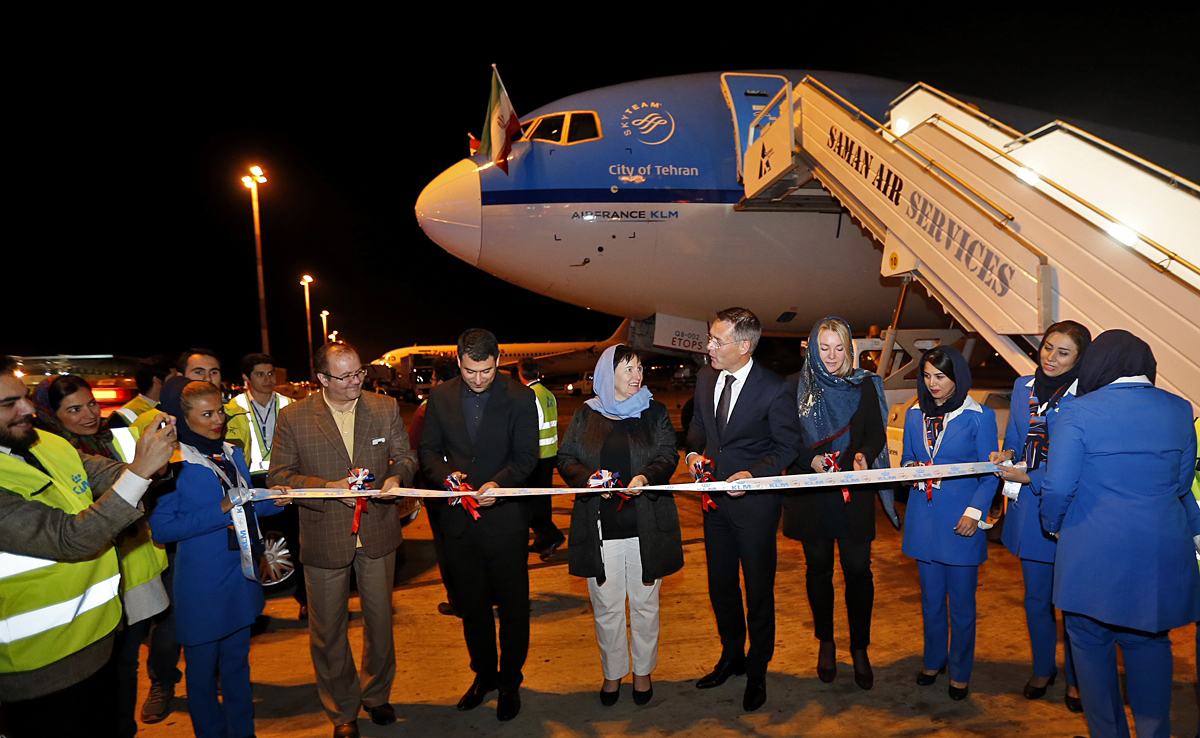Dutch flag carrier KLM has resumed flights to Iran after a three-year hiatus.
Carrying a Dutch trade mission, headed by Minister of Infrastructure and Environment Melanie Schultz van Haegen, on board, a KLM flight landed in Tehran’s Imam Khomeini International Airport on Sunday at 00:05 Tehran local time.
“KLM has tried to strengthen its network by adding Tehran as its 14th new destination in 2016,” KLM President and Chief Executive Officer Pieter Elbers was quoted by the news portal of Iran’s Ministry of Roads and Urban Development as saying.
As per the new schedule, four weekly services will be operated on Sunday, Tuesday, Thursday and Friday between Amsterdam Airport Schiphol and Tehran.
The flights will be operated with a Boeing 777-200. KLM will meet passenger needs by offering three different travel classes: 34 seats in World Business Class, 40 seats in Economy Comfort and 242 seats in Economy Class.
Previously, KLM operated flights to Tehran from July 1991 through April 2013. Including the new flights to Tehran, KLM now offers 37 flights to nine destinations in the Middle East.
The lifting of sanctions against Iran in January, as part of a landmark nuclear deal Tehran signed with world powers in July 2015, has turned Tehran into a new economic frontier and an emerging tourism market, which has caught the attention of international airlines.
The first Air France flight between Paris and Tehran for eight years landed in the Islamic Republic’s capital on April 17, bearing French Transport Minister Alain Vidalies and a business delegation. The airline’s route had been suspended since 2008 because of international sanctions against Iran.
Lufthansa is flying non-stop once again from Munich to Tehran. Starting July 4, the connection under flight number LH 602 will arrive thrice a week in Tehran at 05:20.
British Airways also resumed direct flights to Tehran in September—the first UK carrier to fly to Iran in four years. Six return flights per week now operate between London’s Heathrow and Tehran, which BA described as “an important destination”.
Austria’s national carrier Austrian Airlines started flying three times a week to the Iranian commercial center of Isfahan on September 4. The airline operates an Airbus A320 to the famous Iranian tourist hub located 4,200 kilometers from Vienna on Wednesdays, Fridays and Sundays. Austrian Airlines has expanded its portfolio of up to 14 weekly flights to Tehran by adding Isfahan, thus increasing its services to Iran to 17 flights each week.
Early October, Thai Airways launched a new flight to Tehran. The flag carrier’s launch of four flights per week is projected to double the number of Iranian arrivals to Thailand this year to nearly 200,000 and multiply Thai visitors to the Islamic Republic, currently numbering in the thousands.
Iran is also in talks with Air Canada, Korean Airlines and Air India to establish or increase direct flights.
Boosting Economic Ties
The new direct route between Iran and the Netherlands is expected to boost bilateral economic ties.
The first KLM plane flying to Tehran “will carry Dutch businesspeople with whom I go on a trade visit, to help promote doing business with Iran”, Schultz was quoted by Dutch news outlet Luchtvaart Nieuws as saying.
The Dutch trade mission’s visit, which will end on October 28, is aimed at boosting economic ties and help Dutch companies increase their share in the Iranian market.
The Dutch minister will specifically focus on promoting commercial relations in the fields of port development, maritime technology, water and delta management, and water technology.
“After having been closed to western companies for almost a decade, Iran has an enormous need for knowledge and products in fields in which the Netherlands excels,” Shultz said in a statement available on the Dutch government’s website.
“The country is faced with major water-related challenges. Its water supply is diminishing, which means that it is increasingly difficult to provide the population with drinking water and have sufficient water available for industry and agriculture. This provides Dutch companies with a host of opportunities in the fields of efficient water consumption, water purification and water desalinization. Our companies also have a great deal to offer when it comes to ports and logistics,” the statement further reads.
The trade delegation is going to meet senior Iranian officials in Tehran and Dutch companies will meet their Iranian counterparts. The schedule also includes a visit to the southern Iranian port of Bandar Abbas, which Iran is planning to develop and renovate.
Dutch companies such as BAM, Van Oord and the Port of Rotterdam, whose representatives have joined the visiting trade team, are hoping to clinch deals to help implement part of Iran’s port plans in Bandar Abbas and southeastern Chabahar Port and Special Economic Zone.
Representatives from Damen Shipyards, Royal Boskalis Westminster, Royal IHC, STC Groep and Witteveen + Bos are also accompanying the Dutch minister during the visit.
Adverio Waste systems, Amstelland, Berson UV, Dutch Water Authorities, Interact Smart Solutions, Witteveen + Bos, and the Netherlands Water Partnership are hoping to clinch deals on water management.
According to the Islamic Republic of Iran Customs Administration, Iran exported $58.5 million worth of goods to the Netherlands over the last Iranian year (March 2015-16), which indicates a 15% decline compared to the year before. Last year’s imports from the European country stood at $786.8 million, down 25%compared to the preceding year.
IRICA’s latest data show Iran exported 8,400 tons of non-oil goods worth $18.5 million to the Netherlands during the first six months of the current Iranian year (started March 20), registering a 19% decline compared with the similar period of a year before.
Steel products, molybdenum, cocoa butter, raisins, vegetable seeds, licorice extract, saffron, dates and tiles were among the main exports.
More than 855,600 tons of goods worth $428.8 million were imported from the European country, which indicates a 26% rise year-on-year. The main imported commodities included corn fodder, oilcake, soybeans, grains, medical equipment, pharmaceuticals, baby formula, vegetable seeds, machinery and industrial tools.


